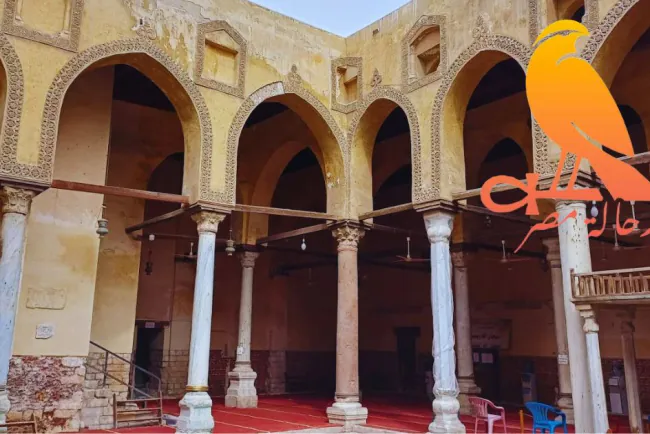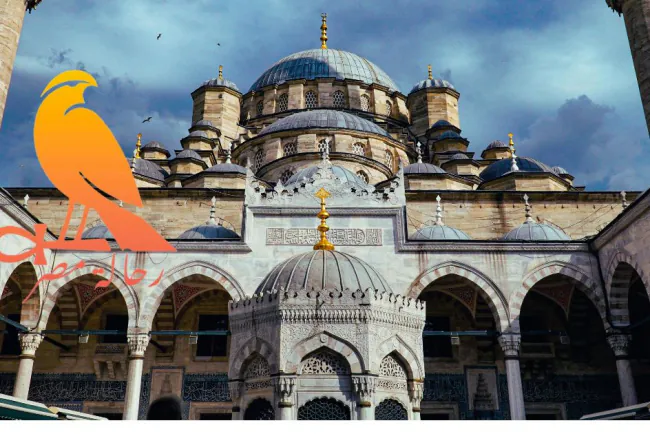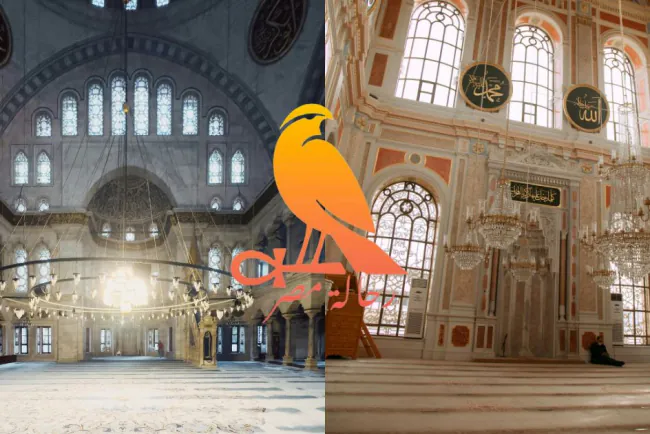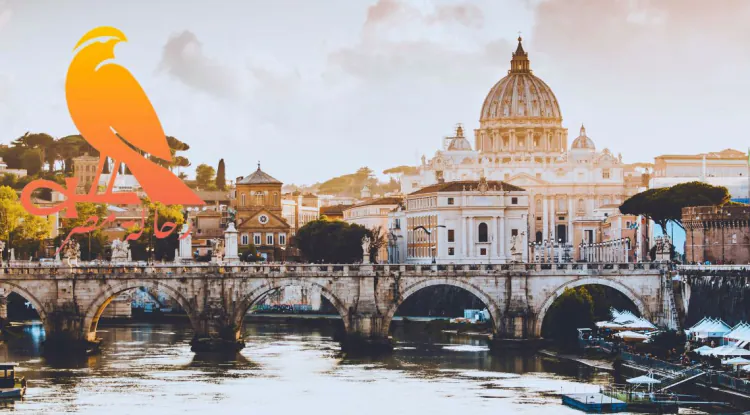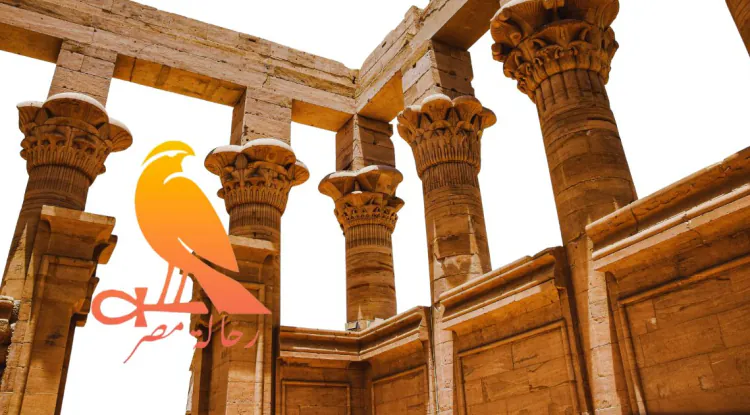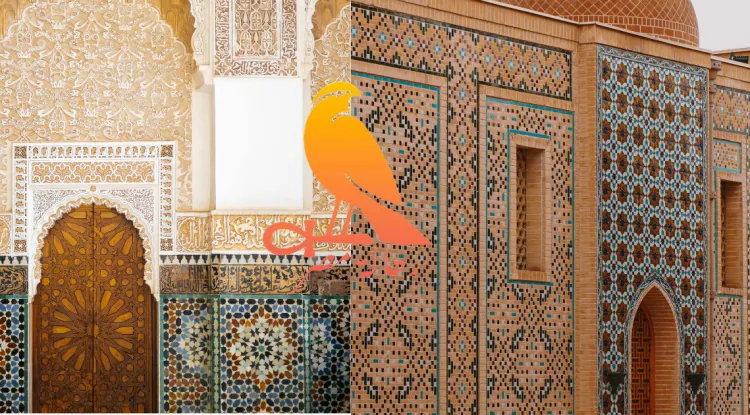The entrance "door" in Islamic architecture
The door appeared in Islamic architecture as an architectural element produced by nature, the land, and the social life of Muslims. It was then crystallized by Islamic civilization, becoming a clear element in the style of Islamic art.

In architectural archaeological terminology, a door (external or internal, main or secondary) is an opening in the wall of a city, fortress, or inn, or in the facade of a mosque, Madrasa, pulpit, palace, house, quarter, Wikala, or other thing that is closed by one or two shutters or more. These shutters may be simple and modest, made of plain wood without decorations, or made of teak wood or inlaid with ivory, mother-of-pearl, and the like, or covered with copper, silver, or gold sheets inlaid or perforated with plant, geometric, and epigraphic designs.
The formal and aesthetic structure:
The formal and aesthetic structure of Islamic art is defined as a type of search for aesthetic, intellectual, and emotional integration that the Muslim artist imbibes through the artistic experience he has acquired from the logic of the Islamic faith regarding the meaning of beauty, which distinguishes Islamic art from other arts of other civilizations. In Islamic art, aesthetic vitality is achieved in the artistic structure in a manner that aspires to cultural communication between man and material, form and expression, transforming decorations into a tangible melody.
Islamic doors:
A door is an entrance to a city wall, the facade of a mosque or palace, the wall of a house, or between rooms. A door may have one, two, or more leaves. Muslims excelled in wood and metal work and used this in the manufacture of doors. One of the most famous types of Arab doors is what is called “sabres,” where the door leaf consists of two columns in which there are holes near the face of the assembly for the separated sabres panels. As for the stuffed doors, they consist of two vertical columns and a number of transverse heads inside which are assembled fillings of Wood thinner than the door bone, the most sophisticated technique achieved by door makers, is used to reveal and decorate doors with raised carvings in geometric and decorative shapes. Perhaps Muslims used small pieces of wood, cutting them, chamfering their edges, and then assembling them in various geometric shapes. Among the most famous shapes are the so-called "star plates." These fillings are inlaid with mother-of-pearl, ivory, or copper.
Another definition of door:
A door is the name given to a door opening, which has an upper and lower threshold of stone or marble. A tall door may be called a shih (a thin tongue), while a large, wide door is called a darb (a doorway), and a door is called a darban (a doorway) (Persian). A door opening may be called an arched door if the top of its opening is arched, or a square door if it has a flat top. This does not mean that the opening is square, but rather square, indicating that the door is not curved.
A door is also what closes the door opening. If the door has a single leaf, it is called a fard (a single door). A large door leaf may have another, smaller, movable leaf through which people pass, called a khokha (a window). Doors may be lined with bronze or iron plates secured with nails. Doors may also be decorated with wooden dovetails fixed to the ribs forming the door frame, in exquisite geometric motifs. The star-shaped plate is considered the most creative of these, and the most creative product of the genius of Muslim artists in geometric motifs.
Islamic decorative art:
Islamic art is distinguished by geometric decorations, which Muslim artists mastered to a great degree, to the point that they became one of the most important features of all Islamic arts. Despite the artistic and intellectual richness that produced these authentic decorative patterns, there are those who attempt to portray this art as merely decorative. This is contrary to the truth and does an injustice to such art, which is considered one of the most creative products of the human hand and mind. It ignores the intellectual, philosophical, scientific, and spiritual dimensions that it left behind. Such art, despite the clear influence of Islamic art on contemporary artistic production.
Islamic art possesses a unique and distinctive identity, shaped and formed by numerous special influences that established its foundations and general characteristics. Geometric motifs received a great deal of attention from Muslim artists, aided by the Muslims' advancement in engineering sciences, the effects of which are evident in the precision and creativity of geometric motifs, as if they were mathematical units intended to demonstrate mathematical thinking to arrive at the absolute truth, unbound by a specific time or place.
Unlike the arts that preceded it, Islam came to liberate art from pagan shackles and priestly captivity, elevating humanity by realizing its humanity. It works through the Islamic conception of existence to build an aesthetic civilization, where Islamic art becomes an intellectual art governed by logic, while at the same time reaching sublime creative realms. Islamic civilization flourished in Egypt, the Levant, Persia, India, Morocco, Spain, and Turkey, becoming one of the greatest civilizations, due to the artistic relics and exquisite abstract engravings it left behind. These were carved on wood, carved on stone, marble, and plaster, inlaid with mother-of-pearl and ivory, woven with colored threads on fabrics and carpets, and pressed onto leather. They were also skillfully engraved on the ceilings and walls of many mosques and palaces, in decorative compositions of delicate and exquisite plant and geometric elements and shapes. They, too, have become models to emulate for the study of decorative arts.
The architecture and methods of Islamic door decoration are distinguished by their aesthetic qualities and unique artistic treatments, combining the sanctity of religious significance with the creativity of the artwork, which inspires joy in the souls of recipients and a desire to contemplate the creations of Arab-Islamic decorative arts and their aesthetic implications, which elevate humanity to the world of eternity and pure intellectual contemplation. "Ornamentation is the pursuit of eternal essence. Ornamentation took on distinctive characteristics that had a great impact in highlighting the civilized appearance of the Muslim Renaissance, and it flourished to a high degree, both in terms of its design and production, and in terms of its themes and methods. They made decorative groups into models in which their imaginations took flight towards infinity, repetition, alternating renewal, and interlacing. They invented star polygons, foliation shapes, and Arabic inlay shapes. This Arabic style in ornamentation still exists." It has been of interest in many countries since it first appeared in Fatimid decoration.
Elements of Islamic Ornamental :
Islamic decoration is diverse, encompassing geometric, plant, linear, human, and animal motifs. It is based on symbolism, through the formulation of natural elements into abstract shapes, i.e., those bearing an abstract geometric character. Islamic decoration combines relief, relief, and surface motifs, avoiding imitation and mimicry. Islamic decoration adopts the approach of abstraction, transformation, summary, reduction, and geometric formulation of forms, guided by the principles of prohibition and permissibility in accordance with Islamic law.
1-Calligraphic Ornamentation:
"Muslim artists introduced Arabic letters as a primary decorative element, utilizing this element to a wonderful aesthetic effect. It became the responsibility of Arab artists to care for calligraphy and adapt it for aesthetic purposes. Various types of calligraphy emerged, including the Kufic (angular) script, characterized by its right angles and straight lines. Later, plant motifs were added to its ends, and it became known as Naskh script. This soft script was initially used for writing manuscripts, but its use became widespread in buildings beginning in the twelfth century. AD, as it was used in the decoration of various artifacts such as fillings, tiles, and textiles.
2. Plant Motifs:
The field of plant motifs is considered one of the important fields in which Muslim artists excelled, as they created various plant forms that departed from the familiar natural forms of abstraction. There is a type of plant motif called "Arabesque," a word European artists used to describe any decorative composition in which elements intertwine.
"The Muslim artist employed units of plant branches in the form of arches, bends, twists, or spirals during the organization of Regular, successive, intertwined, or intersecting, these units appear as geometric shapes due to their abstraction. Their distance from natural phenomena and their proximity to geometric forms give them the ability to fit within a repetitive system. This indicates the dominance of the principle of abstraction in Islamic art.
3. Human and Animal Motifs:
"The Muslim artist formulated models of human and animal forms as decorative units to reflect artistic values. He created shapes that combined animals and birds, blending them with geometric and plant motifs, and varying their value." "Linearity and Texture"
4. Geometric Decorations:
Artists have used geometric decoration in all human civilizations, but the Muslim artist infused it with a new spirit.
He exaggerated in dividing and analyzing it into repeated lines and curves that extend endlessly, so that the viewer can hardly determine its beginning or end. This demonstrates the breadth of his creative imagination and his mastery of mathematics and geometry. Thus, geometric decorations became a distinctive feature of Islamic art in all Arab countries.
Islamic decoration is subject to geometric networks and formal analysis, leading to an open design. Whether geometric, botanical, linear, animal, or human-like, Muslims excelled in geometric motifs and their shapes, including squares, rectangles, circles, and stars, to the point that they devised the star pattern with its multiple sides, a feat unprecedented in any art form before Islam.
What's Your Reaction?








